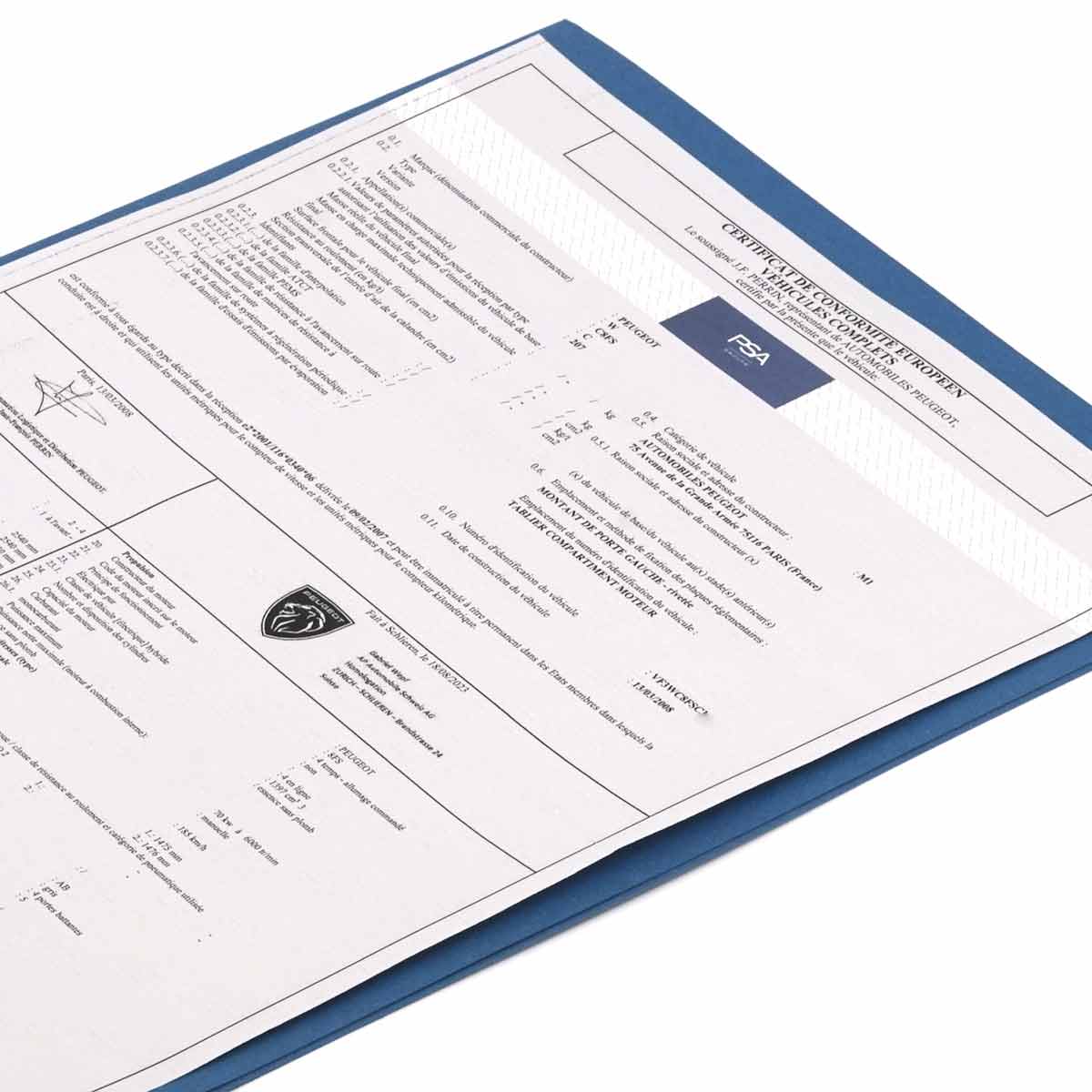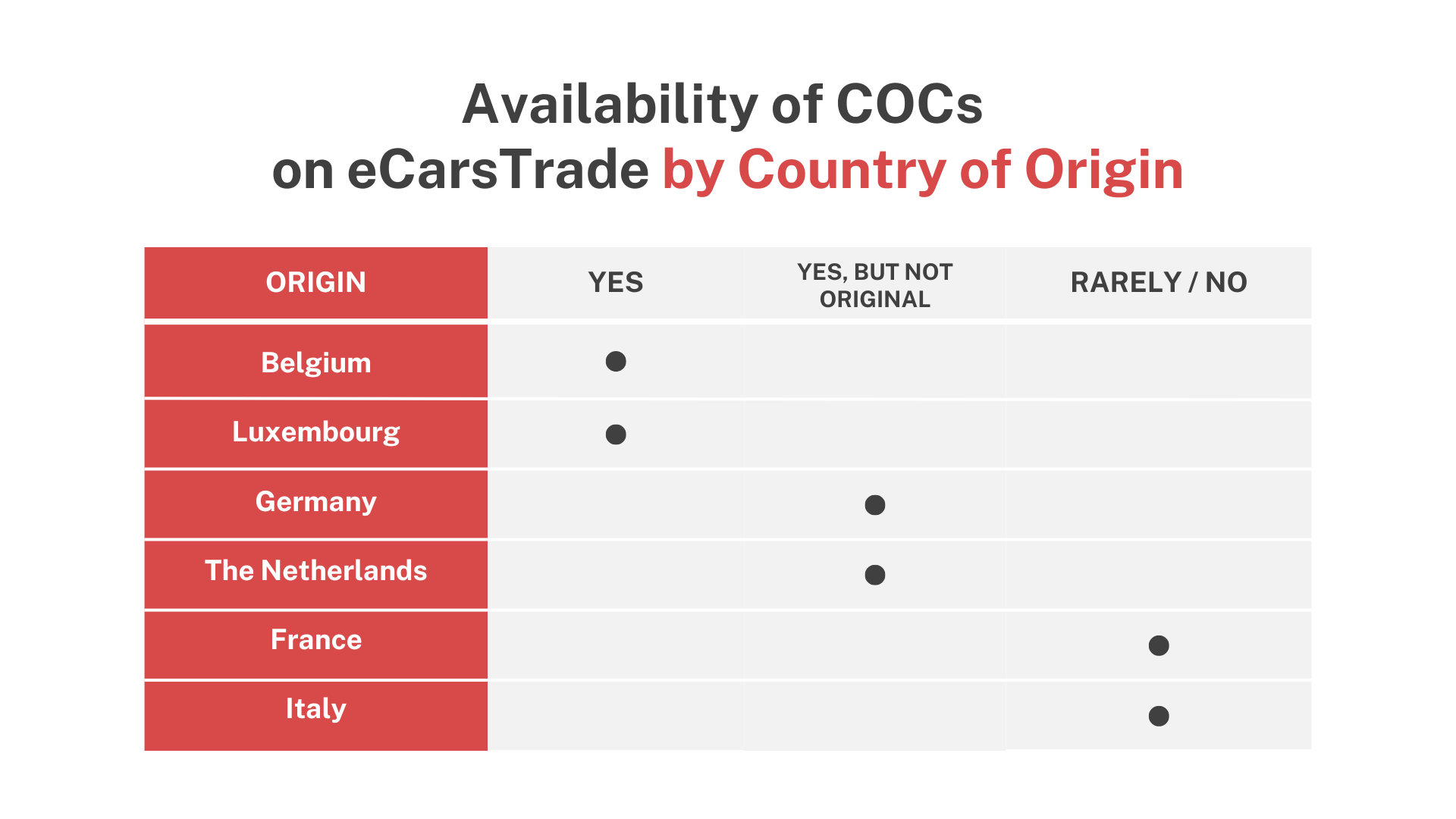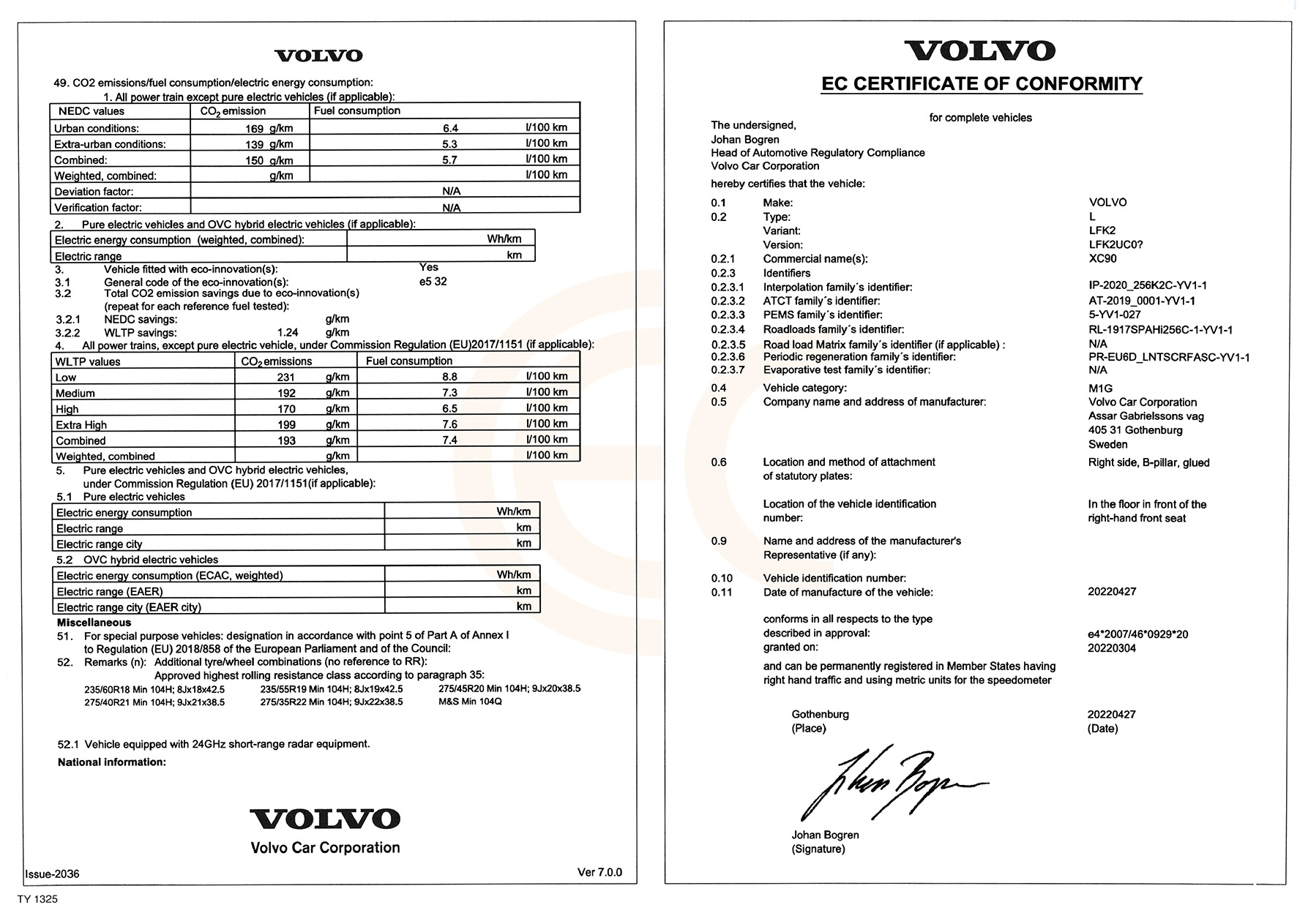- Blog
- ¿Qué es un COC (Certificado de Conformidad) y cómo obtenerlo?
¿Qué es un COC (Certificado de Conformidad) y cómo obtenerlo?
Guía sobre el Certificado de Conformidad (COC): una lectura obligada para los concesionarios de automóviles. Simplifica el cumplimiento, agiliza las transacciones y mejora el servicio a los clientes.

En el complejo mundo de las regulaciones automotrices, el COC es un documento crucial que garantiza que los vehículos cumplan con los estándares y especificaciones establecidos por las autoridades, y las regulaciones de importación del comercio transfronterizo.
Para los concesionarios de automóviles, comprender todo lo relacionado con los COC no se trata simplemente de cumplir con estas reglas: es esencial para mantener el inventario de vehículos en orden y para que tus clientes tengan una buena experiencia de compra.
¿Qué es un Certificado de Conformidad?
Un Certificado de Conformidad (COC) es un documento oficial proporcionado por el fabricante de un vehículo o su representante autorizado, que demuestra que el vehículo cumple con las regulaciones de la UE en el momento de su producción, cubriendo aspectos como las emisiones, la seguridad y los niveles de ruido.
Otra opción muy utilizada es un servicio como EUROCOC, que agiliza la adquisición del COC y garantiza que los vehículos se registren sin problemas.
Ofrecer a tus clientes este certificado junto con la compra de un vehículo proporciona un excelente servicio al cliente y aumenta su satisfacción general.
El propósito del documento.
El propósito del Certificado de Conformidad (COC) es confirmar que un vehículo cumple con los estándares técnicos, ambientales y de seguridad exigidos por los organismos reguladores.
Sirve como prueba de que el vehículo cumple con las especificaciones necesarias para su operación y registro legal dentro de la Unión Europea, y también puede ser necesario para importar vehículos a países específicos fuera de la UE.
El contenido de un AOC: ¿qué debe incluir?
Un Certificado de Conformidad (COC) típico para un vehículo debe incluir información esencial como:
1. Número de identificación del vehículo (VIN)
2. Especificaciones del vehículo (marca, modelo, variante)
3. Confirmación del cumplimiento de las normas de seguridad (por ejemplo, resultados de pruebas de choque)
4. Confirmación del cumplimiento de las normas ambientales (por ejemplo, niveles de emisiones)
5. Confirmación del cumplimiento de las normas técnicas (por ejemplo, especificaciones del motor)
6. Datos del fabricante o representante autorizado
7. Fecha de emisión
8. Referencias o aprobaciones regulatorias
9. Cualquier información adicional requerida por las autoridades pertinentes para fines de registro o importación.
A continuación, te mostramos un ejemplo de COC:
¿Por qué es importante el COC para los distribuidores de la UE?
El comercio transfronterizo de vehículos usados es muy común entre los concesionarios de la UE. El COC es importante para los concesionarios de la UE por varias razones:
1. Legalidad: Dentro de la Unión Europea, los vehículos deben cumplir estrictas normas técnicas, medioambientales y de seguridad. El COC es la prueba de que los coches que están en venta cumplen con estas normas.
2. Matriculación de vehículos: Los concesionarios de la UE necesitan el certificado COC para agilizar el proceso de matriculación de los vehículos. Muchos países de la UE exigen el COC como parte de la documentación de registro para confirmar el cumplimiento de las normas de la UE.
3. Atención al cliente: Proporcionar el COC a los clientes significa que los vehículos del concesionario cumplen con los estándares regulatorios, lo que mejora la experiencia de los clientes en relación a la seguridad, la confiabilidad y el cumplimiento legal.
4. Compra rápida: El acceso rápido a los COC facilita el procesamiento de transacciones de vehículos dentro del concesionario, lo que significa que la venta y el registro será un proceso fluido para los clientes finales.
5. Garantía de cumplimiento: Los concesionarios deben asegurarse de que los vehículos que venden cumplan con las regulaciones de la UE. El mantenimiento de los certificados COC reduce el riesgo de vender vehículos que no cumplan con las normativas.
¿Cómo conseguir un COC?
Los procedimientos y requisitos específicos para obtener un COC pueden variar según el fabricante del vehículo, el origen del vehículo y las regulaciones del país de destino.
Para obtener el Certificado de Conformidad (COC) de un vehículo, sigue estos pasos:
- Comunícate con las autoridades adecuadas: comunícate con el fabricante o su representante para solicitar un COC para el vehículo específico. También puedes utilizar algunos de los servicios en línea populares, como EUROCOC.
- Proporciona la información necesaria: necesitarás proporcionar detalles como el número de identificación del vehículo (VIN) y cualquier otra información solicitada, como la marca, el modelo y la variante del vehículo.
- Presenta la documentación requerida: dependiendo de los requisitos del fabricante y el historial del vehículo, es posible que debas presentar documentación adicional, como una prueba de propiedad o de compra.
- Paga las tarifas aplicables: algunos fabricantes pueden cobrar una tarifa por emitir el COC.
- Recibe el COC: después de que el fabricante o su representante verifiquen el cumplimiento del vehículo, emitirán el COC. Este documento contiene toda la información que certifica la conformidad del vehículo con las normas reglamentarias.
- Utiliza el COC para un registro o una importación: con el COC, puedes proceder con el registro del vehículo dentro de la UE, o también puedes importar el vehículo a países que reconocen o requieren COC para fines de cumplimiento, como Portugal o Italia.
COC para vehículos nuevos o para vehículos usados
El proceso de obtención de un COC para vehículos nuevos o para vehículos usados generalmente implica pasos similares, pero existen algunas diferencias clave:
1. Información del vehículo
Para vehículos nuevos, normalmente debes proporcionar información como el número de identificación del vehículo (VIN), el modelo y la fecha de fabricación.
Para vehículos usados, además del VIN y el modelo, es posible que debas aportar detalles sobre el historial de propiedad anterior y el estado de registro del vehículo.

2. Documentación
Al obtener un COC para un vehículo nuevo, es posible que debas presentar documentos como el contrato de compra o la factura de venta.
Para un vehículo usado, es posible que debas proporcionar documentación adicional para verificar la propiedad y la elegibilidad para el COC, como un comprobante de compra, documentos de registro del vehículo u otra documentación relevante.
3. Tarifas
Si bien los COC para vehículos nuevos y usados pueden tener tarifas, los costos pueden variar. Los fabricantes pueden cobrar tarifas diferentes según factores como la antigüedad, el estado y el historial del vehículo.
4. Proceso de verificación
El proceso de verificación de vehículos nuevos normalmente se centra en confirmar el cumplimiento del vehículo con las normas reglamentarias en el momento de su fabricación.
Para vehículos usados, el proceso de verificación puede implicar la evaluación del historial de cumplimiento del vehículo, incluyendo las modificaciones o reparaciones realizadas desde su fabricación inicial.

5. Aplicabilidad
Los COC de vehículos nuevos a menudo se requieren para fines de registro y cumplimiento, particularmente dentro de la Unión Europea.
Los COC de vehículos usados también pueden ser necesarios para el registro o la importación en ciertos países, pero los requisitos y el reconocimiento de los COC para vehículos usados pueden variar según las regulaciones del país de destino.
Consulta con el fabricante del vehículo o las autoridades pertinentes para comprender los requisitos y procedimientos específicos para obtener un COC, ya sea para un vehículo nuevo o usado. Estos pueden variar según las regulaciones regionales y otros factores.
A veces, los concesionarios no podrán proporcionarte un COC. En eCarsTrade, si el vehículo tiene COC o no depende de su procedencia.
Por ejemplo, la mayoría de nuestros coches de Bélgica y Luxemburgo tienen COC. Los vehículos usados de Alemania y Países Bajos tienen COC, pero no es el COC de la marca original.
Los coches de segunda mano procedentes de Francia e Italia rara vez vienen con COC.
Preguntas frecuentes
► ¿Quién emite el COC al comprar un vehículo usado?
Al comprar un vehículo usado, el COC generalmente viene con el automóvil usado como parte de la documentación del automóvil. Si no se facilita el COC, puedes solicitarlo directamente a la marca del coche o comprarlo online en servicios como EUROCOC.
► ¿Por qué es importante un COC para la matriculación de vehículos en la UE?
El COC es crucial para la matriculación de vehículos dentro de la UE porque confirma el cumplimiento de los estándares regulatorios establecidos por la UE. Sirve como prueba de que el vehículo cumple con los requisitos técnicos, medioambientales y de seguridad necesarios para su matriculación en los estados miembros de la UE.
Si no proporcionas un COC durante el procedimiento de importación o registro, probablemente no podrás importar/registrar el vehículo.
► ¿Qué deben hacer los distribuidores si el vehículo no tiene COC o se ha extraviado?
Si el COC no existe o se ha extraviado, los concesionarios deben comunicarse con el fabricante del vehículo o su representante autorizado para solicitar un duplicado o un reemplazo del COC.
Además, los concesionarios pueden consultar sobre la posibilidad de obtener un COC a través de servicios en línea, autoridades gubernamentales pertinentes o agencias responsables del registro de vehículos.
► ¿El COC es aplicable a vehículos de fuera de la UE?
El COC se aplica principalmente a vehículos dentro de la UE, ya que verifica el cumplimiento de las normas reglamentarias de la UE. Sin embargo, algunos países fuera de la UE (por ejemplo, Suiza, Noruega, Islandia, Liechtenstein) también pueden reconocer y exigir el COC para vehículos importados. Depende de las regulaciones y requisitos específicos para cada país.
► ¿Es un certificado de cumplimiento el mismo documento que un certificado de conformidad?
No, un certificado de cumplimiento (CoC) y un certificado de conformidad (COC) son documentos diferentes, aunque sirven para propósitos similares al verificar el cumplimiento normativo.
El COC, emitido por el fabricante del vehículo o su representante, confirma que un vehículo cumple con los estándares reglamentarios, esenciales para el registro. El CoC es un término más amplio que certifica el cumplimiento de estándares o regulaciones específicas en diversas industrias.
Comprender la importancia de los COC ayuda a los concesionarios a seguir las reglas con seguridad y confianza, lo que aumentará la fidelidad de los clientes.
Conocer todos los detalles sobre los COC te ayudará a mantenerte a la vanguardia en la cambiante industria automovilística y a que tu negocio crezca con solidez.




